Our new year began with a trip to a few new places-the south of Spain and Morocco.
Day 1: Malaga
On the evening of New Year’s Day, we flew into Malaga and began exploring the next morning. We began our day in the Plaza de la Merced where Picasso’s birthplace sits on the corner of the square. The square itself is home to a Picasso statue, several restaurants and is lined by orange trees.

We grabbed some pastries, which we stopped to enjoy in the square, before heading into the city center.

We stopped in a small church where they had a small nativity scene set up which was very lovely.
Next, we walked through the center with all of the shops and restaurants to the Market Atarazanas which was a very cool building with elaborate ironwork and beautiful painted glass. There was a lot of really great produce to be found at the market.
After this, we walked to Episcopal Palace and the Malaga Cathedral. The cathedral only had a small portion that was free to enter but they had an amazing, large nativity scene set up in that area as well as a manger scene made of plant materials on some stone statues set up outside the door.


We wrapped up our morning with a trip to the Roman Theater and Alcazaba, a Moorish fortress. If you don’t know, the Moors were the Muslim people that inhabited and ruled the Iberian Penisula, which Spain is part of, during the Middle Ages. Inside the fortress walls, there were very lovely tropical plants and floors with beautiful designs made from small stones.
After this, it was on to the beach area. We walked through a lush park between the shops and the beach and then down to the water. It was not exactly a beautiful beach area and as the day was a little overcast, the water was not too pretty so we didn’t stay long before going to lunch.

At the restaurant, we began the meal with some aceitunas (olives) and Malaga sweet wine-similar to a port. For the meal itself, we had some local beer, Ensalada Malaguena which was a cold salad with cod and orange segments atop a potato salad type mixture, Pipirrana (a tomato, pepper and onion salad with shrimp and octopus), Rabo de Torro (bull tail) and albondigas (meatballs) in almond sauce. It was all very good!
After lunch, we walked to the bull arena and stopped in a bakery for some molletes (white baked bread) and torta de Aceite (a dry cookie).
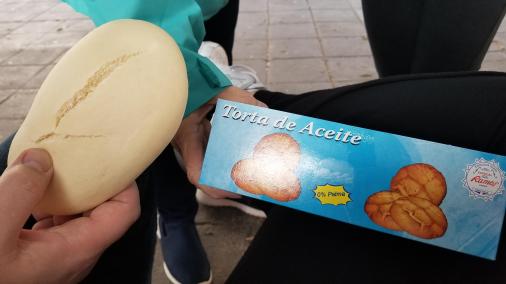
Now, it was time for an uphill climb to Castilo Gibrafaltro-former Moorish castle. There wasn’t much left to the structure itself other than the outer wall and some garden areas but the views were nice from the top. And we got to see a really crazy looking Spanish squirrel!
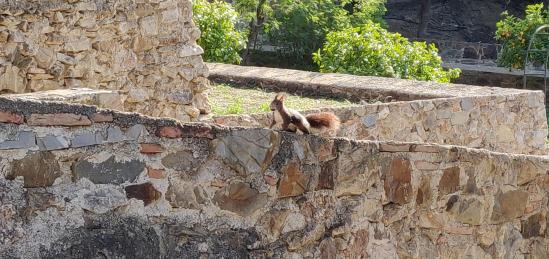
After all that climbing, we decided we deserved a snack so we stopped at one of the restaurants at Plaza de la Merced for some gazpacheulo (a cream-based fish stew) which was delicious, anchovies on Ceasar salad wraps and melon with ham and bruschetta.

After resting for a while, we went out in the evening for dinner at Restaurant Picasso where we had calamari, pork knuckle, roasted beef in a red wine sauce, a pineapple stuffed with greens, walnuts and cheese, albondigas, chicken croquetas, and a Spanish omelet. We also tried two other Malaga wines and some Sangria Malaguena.

Day 2: Gibraltar
On the next day, we drove two and a half hours to Gibraltar. Interestingly, Gibraltar is actually its own territory which governs itself, rather than a part of Spain. However, Gibraltar, having once been a colony of the UK and still under their protection and defense, has a large British influence. In fact, in Gibraltar, the primary language is English although they also know and speak Spanish since they border Spain. But aside from knowing these two languages, Gibraltarians have created their own dialect which is a blend of English and Spanish and is very interesting to hear.
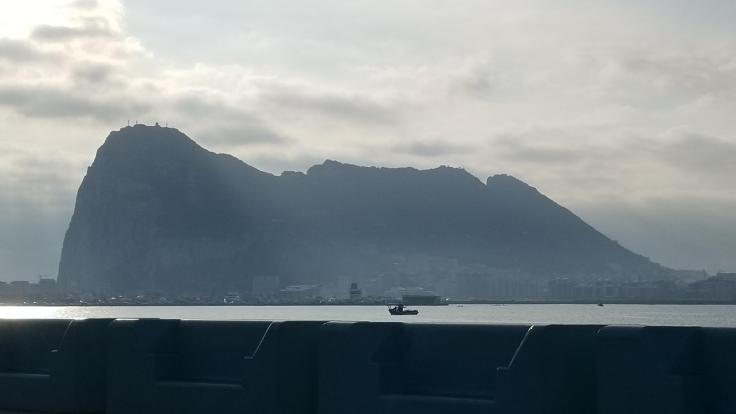
After crossing the border into Gibraltar, we made our way to the water casements market place for lunch. Here we tried Rolitos which was ham, seasonings and chopped olives rolled inside a thin piece of beef and served with a special sauce. We also had Huevos de la Flamenca which was a mixture of peppers and potatoes cooked in a sauce with sausage, serrano ham and a fried egg on top.

After lunch, we took the cable car to the top of the Rock of Gibraltar, which is said to be one of the pillars of Hercules that was left when he broke the mountain between Africa and Europe, to spend the afternoon on the Rock.

After stepping off the cable car, my mother was promptly attacked by one of the large Barbary Macaques that roam freely on the Rock. My kids declared this to be the highlight of the trip, though I’m not sure my mother would agree. The Macaque seemed to be going for her purse, but she managed to wrestle it free, and she and the monkey parted ways. These monkeys are everywhere, though, and it was a while before my mother felt that she was not going to be attacked by another one!

After this initial excitement, we headed to the skywalk to take a look at the views and then to St. Micheal’s Cave which is, according to legend, where the Macaques crossed from Africa to Europe.

After the cave, we tested our ability to conquer our fears when we went across the suspension bridge on the side of the Rock. I wasn’t too scared, but my height fearing children were pretty nervous.

Finally, we took the long walk to the Great Siege Tunnels. We didn’t have time to go very deep into the tunnels, but it was interesting to learn some of the history of Britain’s defense of Gibraltar when the Spanish attempted to regain control in the late 1700s.

Day 3: Tangiers
The third day of our trip brought our long-awaited day trip to Africa (cue the song from Toto if you are anything like our family). It was the first time for all of us to go to the African continent. Our day began very early when the tour company picked us up for a one hour ride to Tarifa, Spain where we embarked on our one and a half hour ferry trip across the Strait of Gibraltar. Upon arriving in Tangiers, we boarded a bus for a driving tour of the new city which is comprised of quarters belonging to different nationalities such as French, Spanish, American, British and Italian. The city is comprised of all of the different nationalities because of the many countries that have controlled Tangiers at various times. On our drive, we drove by some very expensive homes including the home of the mayor of Tangiers and the summer homes of the Moroccan king and the king of Saudi Arabia. Somewhat surprisingly, Tangiers is very green and tropical. Our guide informed us that while two-thirds of Morocco is Sahara, the northern parts are very lush.
Our first stop was at Cap Spartel, where the Mediterranean Sea and the Atlantic Ocean meet.

In this coastal area, we were able to ride camels on the beach. Our son was so excited that the tour guide allowed him to go on three rides instead of just one. It was definitely a bit tricky to feel comfortable on the camel as they are pretty wide and quite jostly, not to mention the awkwardness of the moment that they stand up and lay down with you on their back, but it was quite the experience! While other people in the group (and our son) took their turns, we were able to pet the smaller camels on the beach.
After our camel time was over, we went to the Cave of Hercules which was mainly cut out by man for the purpose of getting rock for use as grinding stones but did have a natural cutout from the water where it is said that you can make out the profile of Hercules.
After the cave, we were taken to the old city or Medina.
Here we walked to our lunch stop where we met a snake charmer along the way, and he did a little display for us.

Our lunch was overlooking the city and the sea in a lovely space with beautiful light fixtures.
During lunch, some local musicians played traditional music for us.

Our lunch consisted of Harira (a soup with chickpeas), bread, chicken kabobs, couscous and tajines (a fruit and vegetable mix). It was all very good and was finished with a delicious mint tea and pastry with honey.
After lunch, we walked through more of the old city including the produce, olive, meat and fish markets. In all honesty, the meat and particularly fish markets were pretty hard to take. The conditions seemed pretty unsanitary but the sheer carnage was a bit much even for those in the group who are not normally squeamish.
After the markets, we walked to a large artisan store selling jewelry, pottery, leather and rugs among other things and then to a pharmacy where we were given a demonstration of the many argon oils and other Moroccan products that they offered (we even received nearly ten samples of products). The pharmacy building itself was quite lovely inside with beautifully carved walls.


After this, we walked through the streets of the Medina where, unlike the new part of the city, Morocco was everything you imagined with street vendors accosting you in an attempt to sell their wares. It was quite overwhelming and a little nervewracking at times, and we were there in low season!
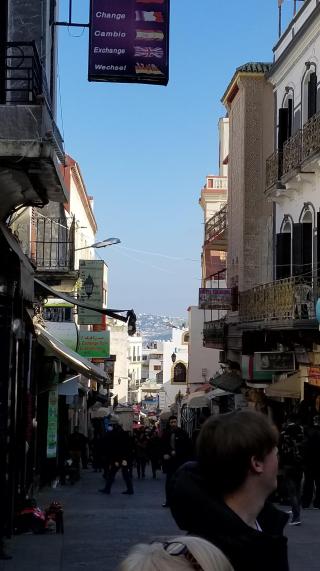
Finally, we were given free time in the streets of the Medina (this was actually a little frightening), but we looked around a little and haggled with a few vendors to make some purchases before getting an outdoor table at Cafe Tanger for some mint tea. The tea was really delicious and watching the street was interesting.
One interesting thing was hearing the call to prayer for the Muslims a couple of times during the day including while we were having our tea. It didn’t seem that anyone stopped what they were doing to pray, but we did see some people coming out of the Mosque shortly after the call to prayer so perhaps some did.

Before our free time was up, my husband and son went with our tour guide to find a store selling pastilla (chicken and spices inside of a flaky pastry). Surprisingly they came back with a box filled with Moroccan pastries as well. All of it was very good!

Finally, our bus driver drove us around the modern area of the city and the new train station and seaport. It was very different than the conditions and life inside the Medina.
After the ferry ride back to Spain and the bus ride back to Gibraltar, we were very tired. It had been a long but exciting day, and we felt very fortunate that we were able to take the opportunity to visit Morocco.
Day 4: Seville
Upon waking up this morning, we looked out our apartment window to find that there was an immense cemetery right behind the apartment. It was really large with lots of stone monuments. This was quite the surprise as we had only been in the apartment before sunrise and after sunset the other days meaning we could never have seen what was there. It was an interesting end to our time in Gibraltar!
After crossing the border back into Spain, we drove to Seville. The drive took us into a very arid region with lots of cacti. Our first act in Seville was an attempt to get lunch. Most places didn’t open until 1:00-1:30 for lunch but we did convince a small restaurant in a small neighborhood outside the city to serve us at noon. We were the only people eating, but we tried several traditional dishes including Espinacas con garbanzos (spinach with garbanzo beans), croquetas, Solomillo al Whiskey (pork with whiskey sauce), Secreto Iberico (pork) and Presa Iberico (beef) along with some Boquerones Fritos (fried anchovies). And since Seville is known for Manzanilla (sherry), we tried a glass, though we did not like it.
After lunch we headed into the city where we first walked along the river to the Plaza do Torros (bull arena). We didn’t go into the actual arena, but we did walk the area between the outer wall and the arena.

Next, we walked to the Cathedral of Seville, a massive cathedral, and the surrounding square before making our way, past many beautiful buildings and fountains, to Plaza de Espana which was a beautiful area that was quite large with gorgeous buildings, a fountain and a circular canal that people were boating on. It really was breathtaking and a great place to sit and enjoy the sunshine and some of the musicians performing around the area.
As we left the area, we ran smack into the Epiphany parade. Having never seen a parade to celebrate Epiphany and having been told that the one in Seville is quite nice, we decided to stay and watch. There were several bands and close to two dozen floats, but the unusual part, aside from figuring out what some of the floats had to do with Epiphany, was the amount of candy being thrown from each and every float. There were at least 10 people or more on each float and each one of those people was hurling the contents of bags upon bags of candy into the crowd.
By the time the parade had passed us, we saw multitudes of children (and some adults) with large sacks stuffed full of candy. In addition, the ground was littered with crushed and whole pieces of hard, wrapped candies. Our shoes quickly became very sticky trying to leave the area.

But lest you were worried about this mess creating a long term problem for the city of Seville, the parade was immediately followed by what can only be described as a brigade of street sweeper vehicles. They were lined up three per row and there were probably four to five rows coming just minutes behind the final float. It was like an army of street sweepers descending on the sticky carnage of a candy battle. Quite a sight to behold! And the parade must have wound around several areas of the city because we saw people coming from other parade routes over an hour later. That’s a lot of candy (and to our environmentally conscious brains, a lot of waste)!
After escaping the candy war zone, we went back to the Cathedral where we found a side entrance that allowed us to see a small section of the cathedral as the rest was closed for Epiphany (which seemed counterintuitive considering Ephiphany is a religious holiday).
From here, we went to see las Sestas, an immense wooden art piece.

We decided to sit and have a coffee outside. We also tried Roscon de Reyes, a Christmas cake, with a whipped cream type filling and candied fruit-tasty!

After our coffee, we walked down to the Flamenco Cultural Center to watch a Flamenco show. We were able to get seats right in the front so we had a very up-close view of the show. You could definitely feel the passion of the performers. It was a very interesting and enjoyable show.

We ended our night with a dinner of mushroom and shrimp risotto, black rice with seafood and an egg, ham and vegetable dish and some local red wine.

Day 5: Granada
As we drove the three hours from Seville to Granada, we moved from the very arid to the mountains-the Sierra Nevada Mountains to be more specific.

Upon arriving in Granada, we went to the Cathedral of Granada and the Royal Chapel (though not inside here) where King Ferdinand and Queen Isabella (as in Christopher Colombus’s backers) are buried.
The sun was shining, so we had lunch outside in a plaza near the cathedral. We tried a complimentary starter that was like a small tuna sandwich on some amazing bread, albondigas, grilled artichokes with ham, shrimp and tuna croquetas and Flamenquina (ham and cheese rolled inside a breading and fried).
After lunch, we walked through the old bazaar and silk market, Alcaceiria, to Corral del Carbon, an old Arab inn and warehouse from the 1300s.
Then we took a sunny stroll along the river Darro past many historic sites and buildings including El Banuelo, an old 11th-century Arab bathhouse. We walked through the Albaizin district under the shadow of the Alhambra (palace and fortress) to the gardens of a former palace home. Then we walked uphill to the Sacramonte district.
After our long walk, we headed down to dinner where we enjoyed Carne en salsa (meat in a really delicious sauce), champignon al Horno (stuffed mushrooms) and Habas con Jamon (beans and ham with a fried egg) and Sangria.

The highlight of dinner though had to be the completely naked man walking down the street (naked except for his shoulder bag) as we sat freezing next to a heater!

After dinner, we drove to our apartment in another section of the city and tried a little traditional dessert of Piononos before bed. It was an interesting dessert of a bread that was sticky and a little soggy with a cinnamon flavoring. It was pretty good!

Day 6: Granada
Our second day in Granada, we spent at a higher elevation at the Alhambra which includes the Nazarin Palaces (a palace built in stages with various sultans adding new areas), General Life (the summer palace) and Alcazaba (the fortress to protect the area). The palace was by far my favorite area with all the beautiful, decorative buildings and garden areas. There is such a Moorish influence in Spain, that at times it was hard to tell if you were in Spain or back in Morocco.
After a couple of hours at Alhambra, we stopped at the Ascension of Our Lady which was a former monastery for Carthusian monks. There wasn’t much to the area as a large portion of it, including the monks sleeping quarters, did not survive the years, but the church was very interesting, especially the sacristy (for my non-Catholic friends, this is where they keep the sacraments) which is toted as the most beautiful sacristy in the world.





Next, we headed to another portion of the city to have a lunch of Plato Alpujarrero (various sausages, potato and egg), Migas (breadcrumb mixture with sausage and bacon), Huevos Rojo (fried egg with potato) and Perenjinas con Miel de Cana (slices of fried eggplant covered in sugar cane syrup). We also tried a Sacromonte beer.
After our lunch, we walked around the area near our apartment and had some drinks in a cafe in the park. The view of the river and the snow-covered mountains offset with the palm trees was really nice.
Finally, we had dinner at the same restaurant in the park where we tried a Granda red wine, Manchego cheese, Jamon de Trevelez, stuffed mushrooms, grilled vegetables, and an assorted fried fish plate.
Day 7: Malaga
Our final day was spent driving back to Malaga to get to the airport. While it was mostly a travel day, we did make time to stop in Malaga for some Tejeringos (churros with various dipping sauces-chocolate and caramel). It was a great ending to a fun trip!

Our new year is definitely off to a great start with a trip in 2 continents, 2 countries, 4 cities and 1 territory, 1 monkey attack, 1 naked man, historical, natural and cultural sites, new foods, new experiences, animal encounters, educational discussions, family time and lots of laughs and memories.
Here’s to more travel adventures in 2020!







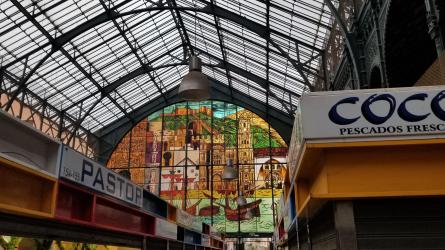

































































































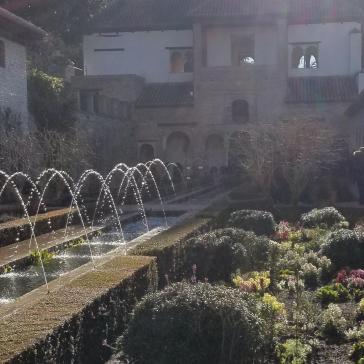









Leave a comment